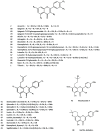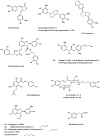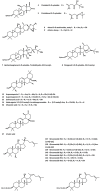Natural Products from Chinese Medicines with Potential Benefits to Bone Health
- PMID: 26927052
- PMCID: PMC6274145
- DOI: 10.3390/molecules21030239
Natural Products from Chinese Medicines with Potential Benefits to Bone Health
Abstract
Osteoporosis is a progressive, systemic bone disorder characterized by loss of bone mass and microstructure, leading to reduced bone strength and increased risk of fracture. It is often associated with reduced quality of life and other medical complications. The disease is common in the aging population, particularly among postmenopausal women and patients who receive long-term steroidal therapy. Given the rapid growth of the aging population, increasing life expectancy, the prevalence of bone loss, and financial burden to the healthcare system and individuals, demand for new therapeutic agents and nutritional supplements for the management and promotion of bone health is pressing. With the advent of global interest in complementary and alternative medicine and natural products, Chinese medicine serves as a viable source to offer benefits for the improvement and maintenance of bone health. This review summarizes the scientific information obtained from recent literatures on the chemical ingredients of Chinese medicinal plants that have been reported to possess osteoprotective and related properties in cell-based and/or animal models. Some of these natural products (or their derivatives) may become promising leads for development into dietary supplements or therapeutic drugs.
Keywords: Chinese medicine; anti-osteoporosis; bone health; natural product; osteoprotection.
Conflict of interest statement
The authors declare no conflict of interest.
Figures







References
-
- International Osteoporosis Foundation: Facts and Statistics about Osteoporosis and Its Impact. [(accessed on 14 December 2015)]. Available online: http://www.iofbonehealth.org/facts-and-statistics.html.
-
- National Osteoporosis Foundation Prevalence Report. [(accessed on 4 December 2015)]. Available online: http://www.nof.org/advocacy/resources/prevalencereport.
-
- Management of osteoporosis in postmenopausal women: 2010 position statement of the North American menopause society. Menopause. 2010;17:25–54. - PubMed
Publication types
MeSH terms
Substances
LinkOut - more resources
Full Text Sources
Other Literature Sources
Medical

